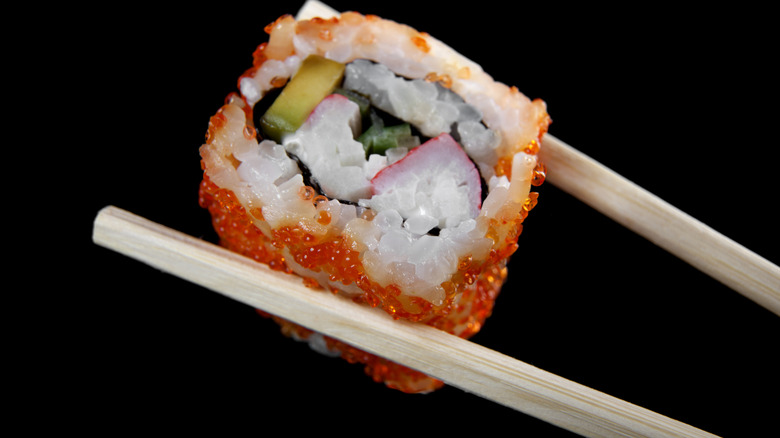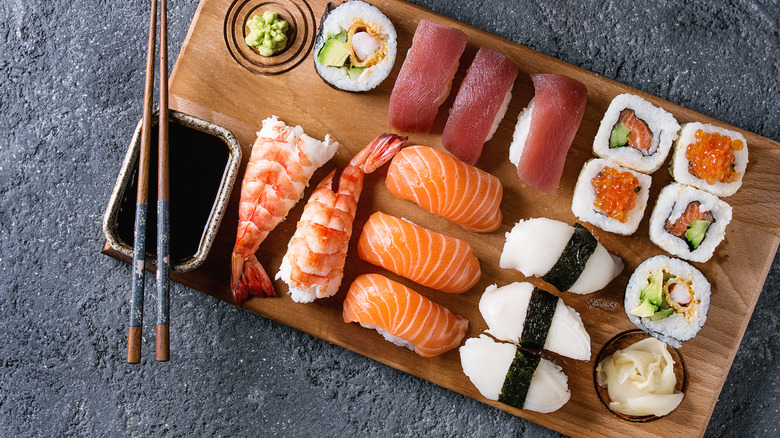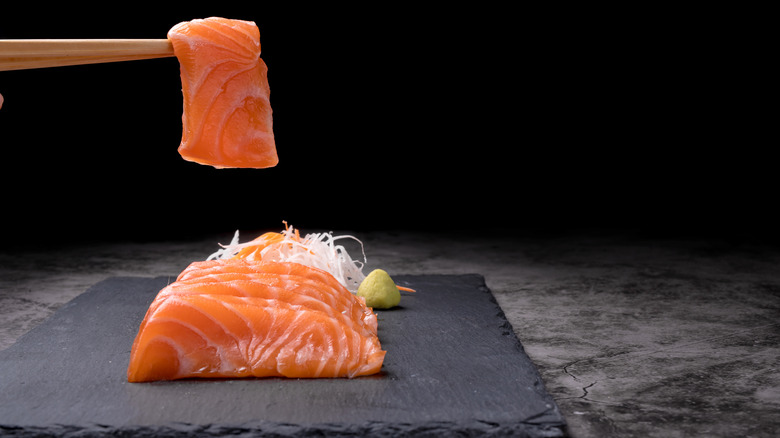When Is It Improper Etiquette To Eat Sushi With Chopsticks?
There are etiquette rules for virtually every dining situation, and these are often dependent on cultural standards. Etiquette can vary widely depending on where in the world you're eating and the type of food you're enjoying. When eating with a knife and fork, you should follow restaurant etiquette regarding where to place your silverware after you're finished, but if you're in a Japanese sushi restaurant and using chopsticks, you have a whole new set of rules to learn.
Most Americans have at least a passing familiarity with Japanese sushi-style restaurants — there are over 15,000 of them in the U.S., after all — but many food lovers outside of Japan are not well-versed in proper chopstick etiquette. Yes, there is a proper place to put your chopsticks when the meal is finished (on the hashi-oki, or chopstick rest), but for certain pieces of sushi, you shouldn't be using chopsticks at all.
There are certain types of sushi that should be eaten by hand, including nigiri, which are basically slices of raw fish placed atop balls of rice. Using chopsticks is not recommended with nigiri, as the delicately-packed rice will fall apart when pinched. Instead, use your hand to gently pick up a piece and dip it into soy sauce, making sure to dip it fish side-down, as the rice ball on the bottom can also fall apart when it touches soy sauce. Handle your nigiri carefully, keep the fish side facing down, and eat the piece in one or two bites.
Which sushi types require chopsticks?
The one or two-bite rule applies to all types of sushi, with one bite preferred if the roll or piece isn't too big. Which types of sushi need chopsticks, and which can be eaten by hand, is a bit more nuanced. Nigiri, as noted, should be eaten by hand, and most sushi rolls should be eaten this way, too. Sashimi, by contrast, should ideally be picked up with chopsticks. That's because sashimi – slices of raw fish with no rice included — is in no danger of falling apart. It's the rice that makes the difference.
In Japan, you'll see most sushi rolls referred to as maki, or makizushi to use its full name. These are among the most commonly-served rolls in most American sushi restaurants and consist of fish and other ingredients rolled up in rice, often with an outer wrapping of nori seaweed. There are also subcategories of this style, such as uramaki, in which the seaweed and rice are inverted so that the latter is on the outside (think California or Philadelphia rolls).
These sushi rolls are all appropriate to eat with one's hands. Yes, you can dip them in soy sauce, too. It's only sashimi that absolutely must be picked with chopsticks, according to traditional etiquette.
Chopstick etiquette for sushi bar connoisseurs
If you're an infrequent visitor to sushi restaurants, just know that eating with your hands is, in many cases, preferred. Some sushi restaurants will even supply a hot towel presented to you at the table, to ensure your hands are clean when food is served.
If you are a sushi bar habitué or simply wish to know more about sushi etiquette, there are a couple of other chopstick-related do's and don'ts. One, deeply rooted in Japanese culture, is an admonition against passing food to others via chopsticks. This is similar to a symbolic Japanese funeral practice in which bones are passed using chopsticks. Doing such a thing at dinner has poor connotations and is considered rude.
Typically, one uses the narrow end of the chopsticks to pick up food, but there are exceptions. In any instance where you're picking up food from someone else's plate or a shared plate, it's considered bad form to use the part of the chopsticks you've been eating with. It's almost like the frowned-upon practice of double-dipping. Use the broad end of your chopsticks instead, which has been in your hand rather than in your mouth.
Some chopstick no-nos are more obvious. Don't rub them against each other, and don't leave them stuck in your rice like ski poles in the snow. This, too, is associated with funerals and death, so it's inappropriate for symbolic reasons. Always place your chopsticks on your chopstick rest when you're not using them.



